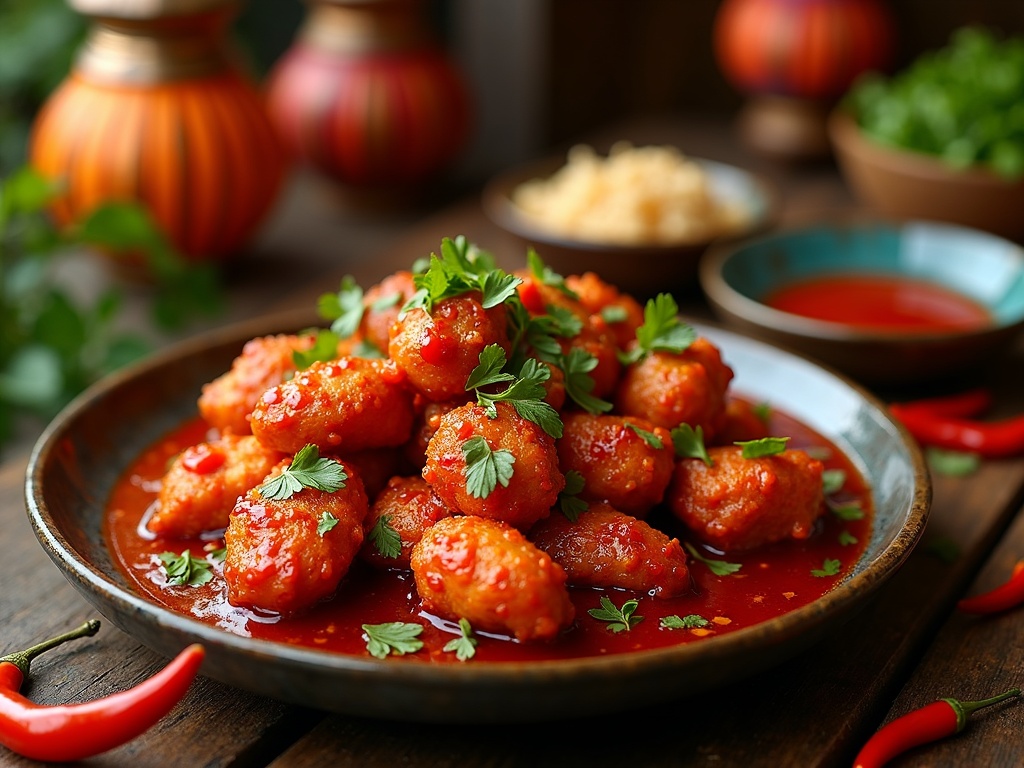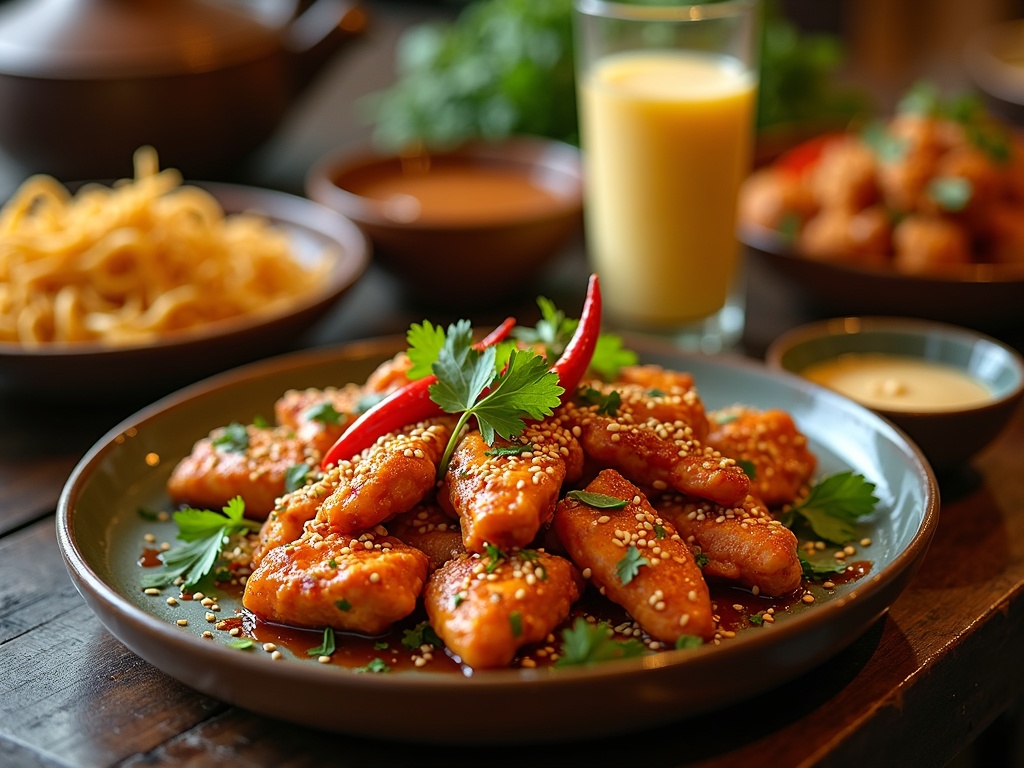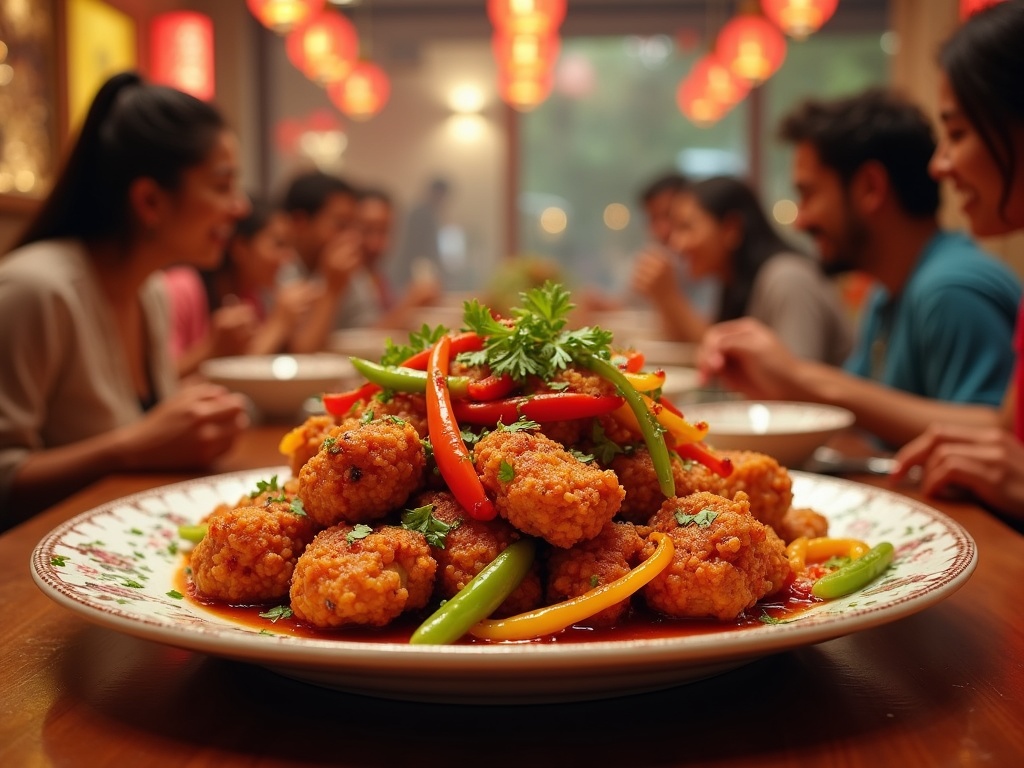Dragon chicken is a vibrant fusion dish that combines Chinese cooking techniques with bold Indian flavors, delivering an impressive heat level exceeding 5,000 Scoville units. This culinary masterpiece features crispy fried chicken pieces tossed in a fiery sauce of fresh red chilies, garlic, ginger, and a sweet-sour base, creating a perfect balance that keeps diners coming back for more.
Find In This Article
Key Takeaways
- Dragon chicken represents a successful marriage between Chinese cooking methods and Indian spice preferences, becoming a staple in Indian-Chinese restaurants.
- The dish follows a two-step cooking process: creating perfectly crispy chicken pieces, then coating them in a signature spicy sauce that maintains the crunch.
- At approximately 250 calories per serving with high protein content, dragon chicken offers a relatively healthier alternative to many other Indo-Chinese options.
- Recipe searches for dragon chicken have increased by 40% year-over-year, transforming it from a niche specialty to a mainstream favorite.
- The dish’s popularity extends beyond restaurants into home kitchens, with many cooks creating adaptations to suit different heat preferences and dietary requirements.
A Fiery Fusion of Chinese and Indian Flavors
Dragon chicken ignites the senses with its remarkable heat—exceeding 5,000 Scoville heat units. This isn’t just spicy food; it’s a culinary adventure that showcases the beautiful marriage between Chinese cooking techniques and bold Indian flavors. The dish has become a staple in Indian-Chinese restaurants, particularly in urban areas where diverse communities have contributed to this unique fusion cuisine.
The Perfect Balance of Heat and Flavor
The magic of dragon chicken starts with perfectly cut chicken pieces, coated in a light, crispy batter that provides the ideal canvas for the explosion of flavors to follow. I’ve found that the batter needs to be just right—not too thick to overwhelm the chicken, yet substantial enough to hold the fiery sauce that gives this dish its name.
After deep-frying to golden perfection, the chicken gets tossed in a sauce that’s simply unforgettable. The key components include:
- Fresh red chilies that bring both color and considerable heat
- Minced garlic that adds depth and aromatic complexity
- Ginger that cuts through with its sharp, fresh notes
- A sweet-sour base that balances the intense spiciness
The result is a dish that tingles the taste buds while leaving you craving more. The bright red appearance is just a warning of the flavor explosion that follows with each bite.
Dragon chicken sits in good company with other Indian-Chinese favorites. If you enjoy this fiery treat, you might also appreciate chilli chicken which offers a similar spicy profile but with its own distinctive character. For something with the same fusion spirit but a different texture experience, chicken Manchurian delivers deep flavors in a rich gravy.
What makes dragon chicken special is how it captures the essence of Indian-Chinese fusion cuisine. Chinese cooking techniques—the quick stir-frying, the balance of textures, the attention to presentation—combine with the Indian love for bold spices and complex flavor profiles. Unlike purely Chinese dishes like chicken chow mein, dragon chicken doesn’t hold back on the heat.
The dish has become particularly famous in urban centers where diverse communities have exchanged culinary ideas. In cities with significant Chinese and Indian populations, restaurants serving this fusion cuisine have thrived, making dragon chicken a beloved dish that crosses cultural boundaries.
For those who appreciate the art of well-seasoned fried chicken but perhaps want a slightly less fiery option, salt and pepper chicken offers the perfect alternative while still delivering on flavor.
The preparation of dragon chicken typically involves a two-step cooking process: first creating perfectly crispy chicken pieces, then coating them in the signature sauce. This technique ensures that the chicken maintains its crunch even after being tossed in the sauce—a textural contrast that’s essential to the dish’s appeal.
I’ve noticed that regional variations exist, with some restaurants increasing the sweetness to balance the heat, while others lean fully into the fiery nature of the dish. Some chefs add bell peppers and onions to provide textural contrast and visual appeal, while others keep it simple to focus on the chicken and its powerful coating.
Whether you’re a spice enthusiast or just someone looking to expand your culinary horizons, dragon chicken represents one of the most successful fusion cuisines—a truly fiery marriage of flavors that continues to gain popularity around the world.

Making the Perfect Dragon Chicken at Home
Dragon chicken combines crispy fried chicken with a fiery sauce that packs a punch. I’ve found that mastering this Indo-Chinese favorite at home gives me full control over the spice level and ingredients, making it much more satisfying than takeout options.
Essential Ingredients
The foundation of dragon chicken relies on quality ingredients that balance heat with flavor. My base recipe includes boneless chicken pieces, corn flour for coating, soy sauce for umami depth, and the aromatic trio of garlic, ginger, and green chili for that signature heat. Bell peppers and onions add texture and sweetness that complement the spicy elements.
What makes this dish particularly appealing is its nutritional profile – at just 250 calories per serving with high protein content and relatively low carbohydrates, it’s a healthier alternative to many other Indo-Chinese options like chicken Manchurian or chilli chicken.
For added dimension, I sometimes include a few drops of sesame oil in the sauce and garnish with spring onions before serving. These optional additions enhance the authentic flavor profile without significantly increasing the calorie count.
Preparation Techniques
The secret to perfect dragon chicken lies in the cooking method:
- Cut chicken into even, bite-sized pieces for consistent cooking
- Create a corn flour coating with salt and pepper
- Double-fry the chicken – first at medium temperature to cook through, then at higher heat for crispiness
- Prepare the sauce separately, getting it to the right consistency before combining
- Toss the chicken in the sauce just before serving to maintain crispiness
I’ve discovered that letting the chicken marinate with ginger-garlic paste for at least 30 minutes before coating it improves flavor penetration. The sauce should be prepared in a separate wok, combining the aromatics first before adding liquid ingredients.
The final dish pairs beautifully with plain rice or can be enjoyed on its own as an appetizer. For those who enjoy Indo-Chinese cuisine, this recipe offers a nice change from standards like chicken chow mein or salt and pepper chicken.
Remember that the heat level can be adjusted by controlling the amount of green chilies used. I prefer to leave some seeds in for extra spiciness, but removing them creates a milder version that’s still full of flavor.
Serving Your Dragon Chicken Creation
Dragon chicken truly comes alive when paired with the right sides and accompaniments. I’ve found that serving this spicy-sweet delicacy with fragrant chicken chow mein noodles creates a balanced meal that satisfies all cravings. Alternatively, simple steamed or fried rice makes the perfect base to soak up that delicious sauce.
While often featured as a main course, dragon chicken makes an impressive appetizer too. Cut into smaller pieces and served with toothpicks, it’s guaranteed to disappear quickly at any gathering. The dish’s vibrant color and bold flavors make it a standout starter that sets the tone for the rest of the meal.
Elevating Your Presentation
To take your dragon chicken to the next level, consider these finishing touches:
- A sprinkle of toasted sesame seeds adds visual appeal and a nutty crunch
- Fresh cilantro leaves brighten both the flavor and appearance
- A light honey drizzle intensifies the sweet-spicy balance
- Red chili slivers create dramatic color contrast and extra heat
Dipping sauces play a crucial role in the dragon chicken experience. Green chili sauce offers a tangy kick that complements the dish’s spiciness, while sweet and sour sauce provides a perfect counterbalance to the heat. I often serve both options to let guests customize their flavor experience.
For beverages, a cold, creamy lassi helps cool the palate between bites of this fiery dish. For adult gatherings, chilled beer pairs surprisingly well with the complex flavors of salt and pepper chicken variants like dragon chicken.
The communal nature of dragon chicken makes it ideal for dinner parties and family gatherings. I like to place it center-table for a dramatic presentation that encourages sharing. Its Indo-Chinese heritage makes it a fascinating conversation starter, especially when served alongside other fusion favorites like chicken Manchurian or chilli chicken.
The versatility of dragon chicken means it fits comfortably in multiple dining scenarios – from casual weeknight dinners to special celebrations. Its bold flavors and striking appearance make it a memorable dish that guests will talk about long after the meal ends.

The Rising Star of Asian Fusion
Dragon chicken has experienced a remarkable surge in popularity, transforming from a niche Indo-Chinese specialty into a mainstream favorite. Recipe searches for this fiery dish have jumped by 40% year-over-year, highlighting its growing foothold in home kitchens. I’ve noticed that what was once considered an occasional restaurant treat has now become a weeknight cooking adventure for many.
From Restaurants to Home Kitchens
Food delivery platforms report dragon chicken as one of their top-ordered dishes, competing with long-established favorites like chicken chow mein and chilli chicken. The dish’s appeal lies in its perfect balance of crispy texture and bold flavors—a combination that’s hard to resist.
Urban areas have become hotspots for dragon chicken’s rising fame. Metropolitan cities with diverse food scenes saw the trend take off first, with suburban areas quickly following suit. Restaurants specializing in Asian fusion cuisine have capitalized on this trend, often featuring dragon chicken as their signature offering.
The past decade has witnessed a consistent upward trajectory in dragon chicken’s popularity. This isn’t just a fleeting food trend but rather a sustained shift in culinary preferences. Similar dishes like salt and pepper chicken have enjoyed comparable growth, but dragon chicken’s unique spice profile gives it a distinctive edge.
Spicy food enthusiasts have embraced dragon chicken with particular enthusiasm. The dish offers a customizable heat level that appeals to those seeking a flavor adventure. Its combination of crispy chicken, vibrant vegetables, and that signature sauce creates a dish that delivers both comfort and excitement.
The recipe’s versatility has contributed significantly to its widespread appeal. Home cooks appreciate how the basic preparation method can be adapted to suit different heat preferences or dietary requirements. While traditional recipes call for deep-frying, many have created healthier air-fryer or baked versions while maintaining the signature flavor profile.
Restaurant chefs have noted that dragon chicken often serves as a gateway dish for diners new to Indo-Chinese cuisine. After trying and enjoying it, customers become more willing to explore other fusion options like chicken Manchurian. This pattern has helped expand the overall market for Asian fusion cuisine.
Social media has played a crucial role in accelerating dragon chicken’s popularity. The visually striking appearance of the dish—with its glossy sauce and vibrant garnishes—makes it highly “shareable” content. Food influencers regularly feature dragon chicken in their content, further fueling public interest.
The combination of convenience, bold flavors, and adaptability positions dragon chicken perfectly for continued growth. As more home cooks master the techniques needed to create restaurant-quality versions at home, the dish’s popularity shows no signs of slowing down.
Dragon chicken represents more than just a trending recipe—it symbolizes the evolving American palate that increasingly embraces global flavors and heat-forward dishes. Its journey from specialty restaurant offering to household favorite illustrates how culinary boundaries continue to expand and blend.
Cultural Impact and Global Appeal
Dragon chicken stands at the crossroads of culinary innovation and cultural exchange. I’ve noticed how this fiery dish has become a symbol of modern food globalization, bringing together Chinese cooking techniques with Indian flavor preferences.
Bridging Culinary Traditions
The evolution of dragon chicken beautifully demonstrates how recipes adapt as they cross borders. Unlike strictly traditional dishes, dragon chicken represents a willingness to blend culinary practices while maintaining respect for both traditions. The dish combines the Chinese stir-frying technique with the bold, spicy flavors characteristic of Indian cuisine.
When I talk about successful adaptations in global cuisine, few examples stand out as clearly as dragon chicken. Its popularity stems from finding the perfect balance between:
- Familiar cooking methods that appeal to Chinese food lovers
- Spice levels that satisfy heat-seeking diners
- Textural elements (crispy exterior, tender interior) that transcend cultural preferences
- Visual appeal that makes it instantly recognizable
Dragon chicken’s closest cousins include dishes like chicken Manchurian and chilli chicken, which share similar fusion roots.
From Street Food to Global Phenomenon
What makes dragon chicken particularly interesting is how it reflects changing dining preferences across diverse communities. The dish has followed a fascinating trajectory:
Originally appearing in Indo-Chinese restaurants, dragon chicken has now found its way onto menus worldwide. I’ve seen it featured alongside traditional favorites like chicken chow mein in restaurants across North America, Europe, and beyond.
Its appeal cuts across demographic lines—enjoyed by adventurous foodies, comfort food seekers, and those looking for something with a bit of heat like salt and pepper chicken. This cross-cultural acceptance demonstrates how food can break down cultural barriers.
The dish’s playful name adds to its mystique and marketability, making it both memorable and intriguing to first-time diners. The “dragon” element suggests heat and excitement—exactly what the dish delivers.
Dragon chicken perfectly exemplifies successful cultural fusion in modern cuisine. It takes elements from different culinary traditions and creates something entirely new yet familiar enough to be accessible. This pattern of adaptation and innovation continues to shape global food culture, with dragon chicken leading the charge as one of the most recognized fusion dishes worldwide.

Sources:
Understanding the Indian-Chinese Crossover Cuisine
Growing Trends in Asian Culinary Preferences
Nutritional Comparison of Traditional Fried vs. Fusion Dishes
Food Delivery Trends: What’s Hot Right Now

